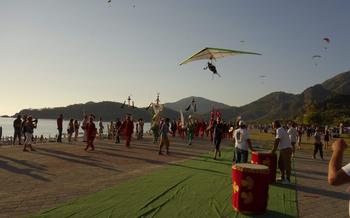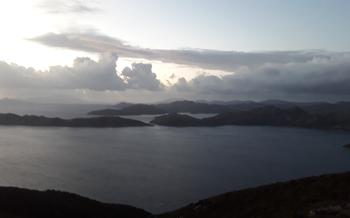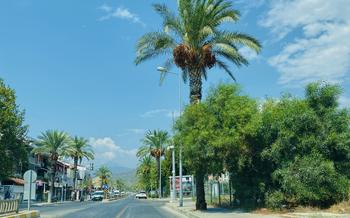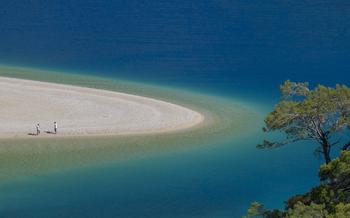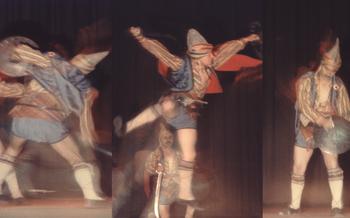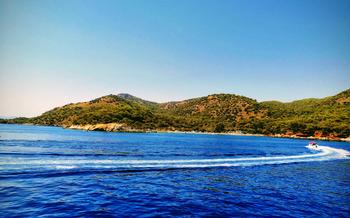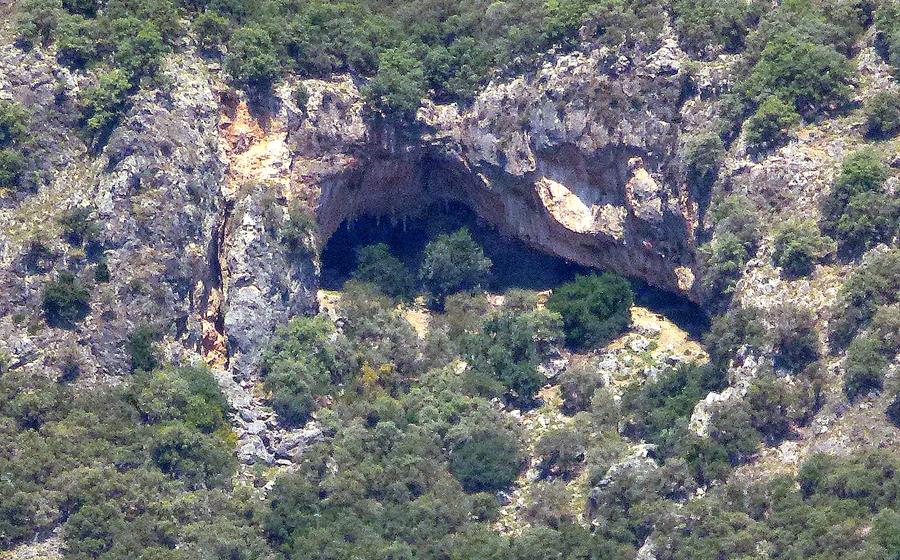
Cadianda Ancient City
- The Antiquity of Cadianda
- Location and Accessibility
- Preservation and Restoration Efforts
- Best Time to Visit
- Exploring the Ruins
- The Theater
- The Temple of Apollo
- The Agora
- The Necropolis
- The City Walls
- The Lycian Way
- Nearby Attractions
- Local Cuisine
- Insider Tip
The Antiquity of Cadianda
The ancient city of Cadianda, nestled in the foothills of the Taurus Mountains, holds a significant place in the annals of history. Its origins can be traced back to the 4th century BC, when it was founded by the Lycians, an ancient civilization that inhabited the southwestern region of Anatolia. Cadianda flourished as a prominent city-state, maintaining close ties with other Lycian cities and playing a pivotal role in the region's political and economic affairs.
Over the centuries, Cadianda experienced various periods of prosperity and decline, influenced by the shifting tides of power and the rise and fall of different empires. It came under the control of the Persian Achaemenid Empire, the Hellenistic Seleucid dynasty, and eventually the Roman Republic, which incorporated Cadianda into its vast domain. Throughout these periods, the city continued to thrive, leaving behind a rich legacy of architectural wonders, inscriptions, and artifacts that provide valuable insights into its past.
In the 7th century AD, Cadianda, like many other ancient cities in the region, faced a period of decline and eventual abandonment. The exact reasons for this are still a subject of scholarly debate, with theories ranging from natural disasters to political turmoil and economic decline. However, the ruins of Cadianda, with their well-preserved structures and intricate carvings, stand as a testament to its once-glorious existence and invite visitors to explore the remnants of a bygone era.
Location and Accessibility
Located at the crossroads of ancient civilizations, Cadianda lies in the southwest of Turkey, in the picturesque Muğla province. Its proximity to the vibrant coastal city of Fethiye, just 48 kilometers away, makes it an easily accessible historical gem. Whether you choose to explore independently or seek the insights of a knowledgeable local guide, reaching Cadianda is a breeze.
To fully immerse yourself in the ancient world, consider renting a car and embarking on a scenic drive through the breathtaking Turkish landscape. The journey offers stunning views of the Taurus Mountains and meanders through charming villages nestled amidst olive groves and pine forests. Alternatively, hop on a local bus from Fethiye, which conveniently drops you off near the entrance to the ancient city.
Once you arrive at Cadianda, prepare to be captivated by its tranquil ambiance and well-preserved ruins. Stroll through the ancient streets, marveling at the remnants of a once-thriving civilization. Let your imagination soar as you explore the theater, temples, and agora, each whispering tales of a bygone era.
Remember, while exploring Cadianda, embrace the spirit of discovery and respect the sanctity of this historical treasure. Tread lightly, preserving the legacy of this ancient city for generations to come.
Preservation and Restoration Efforts
Despite its historical significance, Cadianda has faced several challenges in preserving its ruins and artifacts. Natural factors such as earthquakes and erosion have contributed to the deterioration of the structures, while human activities like looting and illegal excavations have also taken a toll. However, concerted efforts are underway to protect and restore the ancient city.
Local authorities, in collaboration with archaeologists and international organizations, are actively involved in conservation projects. These initiatives focus on stabilizing the ruins, repairing damaged structures, and conducting archaeological surveys to uncover more information about Cadianda's past. The restoration work also includes cleaning and documenting artifacts, as well as implementing measures to prevent further decay.
One of the ongoing projects at Cadianda is the restoration of the theater. This iconic structure, which once hosted performances and civic events, is being carefully repaired to ensure its stability and preserve its architectural features. The project involves cleaning the seating areas, reinforcing the stage, and restoring the intricate carvings and inscriptions that adorn the theater.
By undertaking these preservation and restoration efforts, Cadianda is being brought back to life, allowing visitors to experience the majesty of this ancient city. The work is ongoing, and the goal is to create a sustainable environment for the preservation of Cadianda's rich cultural heritage for generations to come.
Best Time to Visit
The best time to visit Cadianda is during the shoulder seasons, from April to May and from September to October. The weather during these months is generally mild and pleasant, with warm days and cool nights. This makes for ideal conditions for exploring the ruins and enjoying the surrounding natural scenery.
Summer months in Cadianda can be hot and crowded, as the ancient city is a popular tourist destination. If you are visiting during this time, it is recommended to arrive early in the morning or late in the afternoon to avoid the midday heat and crowds. The ruins are also beautifully illuminated at night, offering a unique and magical experience.
Winter months in Cadianda can be cold and rainy, making it less suitable for outdoor exploration. However, the ancient city takes on a different charm during this time, with a misty atmosphere and fewer visitors.
Special events or festivals are occasionally held at Cadianda throughout the year. These events often showcase traditional Turkish culture and heritage, and offer a unique opportunity to experience the ancient city in a different light. It is worth checking local tourism websites or contacting the Fethiye Tourism Information Center for more information about upcoming events.
Exploring the Ruins
Cadianda's ruins offer a glimpse into the city's rich history and architectural legacy. The ancient city's layout is divided into distinct areas, each with its own unique features and significance.
The theater, with its impressive seating capacity, is a testament to the city's vibrant cultural life. Its well-preserved stage and orchestra provide a glimpse into the performances and assemblies that once took place within its walls.
The Temple of Apollo, dedicated to the revered Greek and Roman deity, stands as a symbol of Cadianda's religious devotion. Its intricate columns and decorative elements reflect the city's artistic prowess.
The agora, the bustling heart of Cadianda, served as a central marketplace and public gathering place. Its shops, stalls, and other structures evoke the vibrant atmosphere of trade, commerce, and social interactions that once took place there.
Beyond the city walls lies the necropolis, a solemn reminder of Cadianda's mortuary practices. The variety of burial practices and tomb types, including rock-cut tombs and sarcophagi, offer insights into the city's beliefs and customs surrounding death and the afterlife.
The defensive walls that once protected Cadianda from invasions and attacks are a testament to the city's strategic importance. Constructed using sturdy materials and techniques, the remaining sections of the walls stand as a testament to the city's resilience and determination.
The Theater
The ancient theater of Cadianda is a remarkable architectural feat that offers a glimpse into the city's cultural and entertainment life. Built in the Hellenistic period, the theater boasts an impressive seating capacity, with tiers of stone seats rising in a semi-circular formation. Its stage, adorned with intricate reliefs and decorative elements, once hosted performances, assemblies, and civic events.
Despite the ravages of time and natural disasters, the theater remains in a relatively well-preserved state. Restoration efforts are ongoing to maintain its structural integrity and preserve its unique features. Visitors can still admire the intricate carvings, inscriptions, and architectural details that adorn the theater's facade and interior.
While the theater is no longer in use for its original purpose, it occasionally hosts cultural events and performances during the summer months. These events provide a unique opportunity to experience the theater's acoustics and ambiance while immersing oneself in the ancient world's cultural traditions.
The Temple of Apollo
In the heart of Cadianda's ancient ruins lies the majestic Temple of Apollo, a testament to the city's deep religious devotion and cultural heritage. Dedicated to the revered Greek and Roman deity Apollo, the temple stands as a symbol of his divine presence and the profound influence of Hellenic mythology on Cadianda's people.
The temple's architectural design is a testament to the city's skilled artisans and their mastery of classical Greek architecture. Its imposing columns, intricately carved with delicate motifs, gracefully support a triangular pediment that once showcased vibrant sculptures depicting scenes from Apollo's divine realm. The temple's interior was adorned with opulent frescoes and statues, creating a sacred ambiance that inspired awe and devotion among its worshippers.
Historical records suggest that the Temple of Apollo was the focal point of religious rituals, ceremonies, and festivals held in honor of the revered deity. Devotees gathered within its hallowed halls to offer prayers, make offerings, and seek divine guidance. The temple served as a sanctuary for spiritual contemplation and a place where the community came together to celebrate Apollo's divine patronage.
Unfortunately, the ravages of time and the decline of Cadianda led to the temple's eventual abandonment and decay. Many of its sacred artifacts were lost or destroyed, and the temple's once-vibrant colors faded with the passing centuries. Today, visitors can still marvel at the temple's enduring grandeur, its imposing structure a poignant reminder of Cadianda's rich religious history and the enduring legacy of Apollo.
The Agora
The agora, or marketplace, was the bustling hub of activity in ancient Cadianda. This central gathering place was a vibrant mosaic of commerce, politics, and social interactions. Here, merchants from far and wide set up stalls to sell their wares, from exotic spices and textiles to locally produced pottery and agricultural goods. The air was filled with the sounds of bartering, laughter, and the clinking of coins.
Beyond its commercial function, the agora served as a crucial venue for public assemblies and civic discussions. Citizens from all walks of life would gather to debate issues, make decisions, and learn about the latest news and developments. The agora was also a place for religious ceremonies and festivals, bringing the community together in celebration and devotion.
Excavations at the agora have revealed numerous shops, stalls, and other structures that once lined its perimeter. These include a bakery, a butcher's shop, and a tavern, providing a glimpse into the daily lives and culinary habits of the Cadiandians. The agora was undoubtedly the heart of the city, a place where people from all backgrounds came together to trade, socialize, and shape the course of their community.
The Necropolis
Located just outside the city walls, the necropolis of Cadianda is a fascinating glimpse into the ancient city's mortuary practices and beliefs. Here, among the rocky slopes and scrubland, lie a variety of tombs and burial chambers, each telling a unique story about the lives and deaths of Cadianda's inhabitants.
Some of the tombs are simple rock-cut chambers, while others are more elaborate, featuring intricate carvings and inscriptions. Sarcophagi, or stone coffins, are also common, often adorned with elaborate reliefs depicting scenes from mythology or everyday life.
The necropolis offers a glimpse into the diverse religious beliefs and practices of ancient Cadianda. Some tombs contain evidence of Christian burials, while others suggest pagan rituals. Funerary inscriptions and artwork provide valuable insights into the beliefs and values of the city's residents.
Exploring the necropolis is a humbling experience, reminding us of the fragility of life and the enduring legacy of death. It is a place to pause and reflect on the lives of those who came before us, and to appreciate the rich cultural heritage of this ancient city.
Tips for Exploring the Necropolis:
- Be respectful of the site and its significance. Avoid touching or disturbing any of the tombs or artifacts.
- Wear sturdy shoes and bring a flashlight, as some of the tombs are dark and uneven.
- Take your time to explore the necropolis and appreciate the variety of burial practices and customs represented.
- If you are interested in learning more about the necropolis and its significance, consider hiring a local guide who can provide insights and context.
- Remember, the necropolis is a place of remembrance and reflection. Be mindful of your behavior and avoid any actions that might be disrespectful to the deceased or their families.
The City Walls
Encircling the ancient city of Cadianda, the sturdy city walls stand as a testament to the ingenuity and defensive prowess of its inhabitants. Constructed from massive blocks of stone, these fortifications provided a formidable barrier against potential invaders. The walls featured strategically placed towers and gates, allowing for surveillance and controlled access to the city.
Despite the ravages of time and the relentless march of history, significant portions of the city walls remain intact, offering a glimpse into Cadianda's past. Visitors can trace the perimeter of the ancient city, marveling at the precision and craftsmanship of the stonework. The walls not only served as a physical defense but also symbolized the resilience and determination of the Cadian people.
Preservation efforts are ongoing to protect and restore these iconic structures, ensuring their legacy for generations to come. Archaeological excavations near the walls have unearthed artifacts that shed light on the construction techniques and modifications made over the centuries. These discoveries provide valuable insights into the city's defensive strategies and its adaptation to changing threats.
Exploring the city walls offers a unique opportunity to appreciate Cadianda's rich history and its strategic importance in ancient times. Whether admiring the imposing gateways, ascending the watchtowers, or simply marveling at the sheer scale of the fortifications, visitors are sure to be captivated by the enduring presence of these ancient guardians.
The Lycian Way
Located at the crossroads of ancient civilizations, Turkey boasts a rich tapestry of historical sites and natural wonders. Among them, the Lycian Way stands out as a captivating long-distance hiking trail that traverses the southwestern coast of the country, offering breathtaking views, historical landmarks, and a chance to immerse oneself in the region's rich cultural heritage.
As you explore the ruins of Cadianda, you'll find yourself in close proximity to the Lycian Way route. This presents an enticing opportunity to combine your visit to the ancient city with a section of this iconic hike. The Lycian Way winds its way through stunning landscapes, passing by ancient ruins, picturesque villages, and pristine beaches.
Whether you're an experienced hiker or simply seeking a leisurely stroll, there's a section of the Lycian Way that suits your fitness level and interests. Along the trail, you'll encounter historical sites such as abandoned churches, ancient tombs, and remnants of ancient civilizations. The natural beauty of the region is equally captivating, with towering mountains, lush forests, and secluded coves waiting to be explored.
If you're short on time, consider hiking a portion of the Lycian Way that passes near Cadianda. This will allow you to experience the best of both worlds, combining ancient history with breathtaking natural scenery. Alternatively, if you have more time to spare, you can embark on a longer section of the trail, immersing yourself in the rich history and diverse landscapes that the Lycian Way has to offer.
Nearby Attractions
Cadianda's proximity to other historical sites and natural wonders in the Fethiye region makes it an ideal starting point for further exploration. Just a short drive away, visitors can discover the ancient ruins of Tlos, with its impressive acropolis and well-preserved theater. The village of Kayaköy, also known as Levissi, offers a glimpse into the region's past as a melting pot of cultures, with its abandoned Greek Orthodox churches and houses.
Nature enthusiasts will delight in the stunning beaches and coves that dot the coastline near Fethiye. Ölüdeniz, renowned for its turquoise waters and white-sand beach, is a must-visit. The Blue Lagoon, with its shallow, crystal-clear waters, provides a perfect spot for swimming, snorkeling, and sunbathing. For those seeking adventure, paragliding from Babadağ Mountain offers breathtaking views of the surrounding landscape.
To experience the region's natural beauty on foot, embark on a section of the Lycian Way, a long-distance hiking trail that traverses the Mediterranean coast of Turkey. The trail passes through ancient ruins, picturesque villages, and stunning coastal landscapes, offering a unique way to explore the region's rich history and natural heritage.
Whether you're interested in history, nature, or simply soaking up the local culture, the Fethiye region offers an abundance of attractions to satisfy every traveler's curiosity.
Local Cuisine
When visiting Cadianda, don't miss the opportunity to savor the delights of Turkish cuisine. Fethiye and its surroundings offer a diverse range of restaurants and eateries, from traditional Turkish ocakbaşı grills to cozy cafes and modern fusion establishments. For an authentic culinary experience, try local specialties like meze platters featuring an array of small dishes, succulent kebabs grilled to perfection, and fresh seafood caught from the nearby Mediterranean Sea.
For those who want to delve deeper into Turkish gastronomy, consider taking a cooking class or joining a culinary tour. Learn the secrets of traditional recipes, master the art of rolling perfect börek pastries, and discover the vibrant flavors of Turkish spices and herbs. These immersive experiences will not only satisfy your taste buds but also provide a unique insight into Turkish culture and culinary traditions.
Insider Tip
-
For an unforgettable experience, visit Cadianda during the golden hour, as the setting sun casts a warm glow on the ruins, creating a magical ambiance.
-
Discover the hidden gem of the ancient cistern, located near the theater. Descend into its depths to witness the impressive water storage system that once supplied the city.
-
Escape the crowds by venturing off the main path to explore lesser-known corners of the site. You may stumble upon hidden ruins, serene overlooks, or tranquil spots for contemplation.
-
Engage with the local community by visiting nearby villages and interacting with the friendly residents. Learn about their traditions, crafts, and daily life to gain a deeper understanding of the region's culture.
-
Respect the historical significance of Cadianda by refraining from climbing on the ruins or removing any artifacts. Help preserve this ancient treasure for future generations by following responsible tourism practices.
